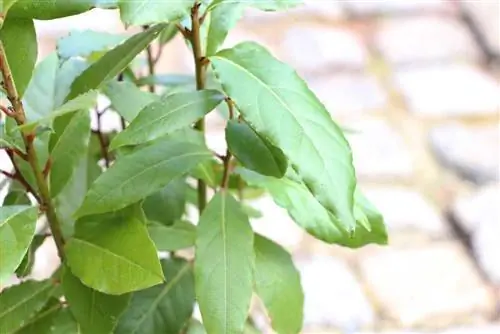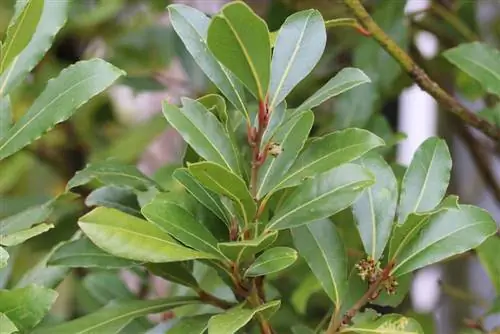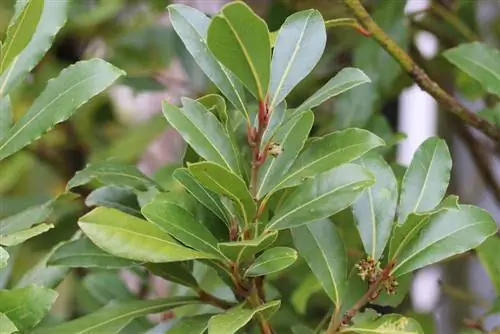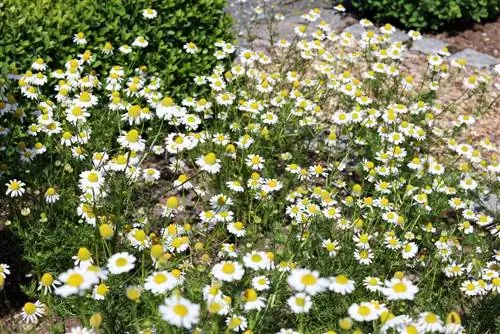- Author admin [email protected].
- Public 2023-12-17 03:39.
- Last modified 2025-06-01 06:48.
Here you can usually find the real laurel in pots. In the wild it can actually only survive in the warm regions of Germany and with appropriate winter protection. Laurus nobilis is a species of plant from the laurel family (Lauraceae). Small white-yellow flowers grow in May, followed by dark purple berries later. With an elegant topiary, for example as a ball or pyramid, you can enchant the terrace and garden with its Mediterranean charisma.
Location
Loving the warmth and being spoiled by the sun in its countries of origin, the real laurel needs a location in full sun and protected from the wind. It cannot survive harsh, cold winds or long periods of frost below -5 °C. It is therefore usually planted in containers or pots. In the mild regions of Germany, for example on Lake Constance, in the Rhineland or by the sea, it can also be planted outdoors in a full sun, protected location. Too little sun not only slows growth, but also makes the laurel more susceptible to disease. It needs at least five hours of sun a day. With the first light frosts in autumn, the pots must move into their winter quarters and the outdoor trees must be protected accordingly.
Floor
The spice laurel is less demanding when it comes to soil quality. Simple potting or garden soil is sufficient. It tends to like nutrient-rich and well-drained soil. The soil can be made more permeable by adding sand.
Watering and fertilizing
In the pot, as well as outdoors, good drainage must be ensured to prevent waterlogging. However, regular watering, preferably with rainwater, is important in summer, because the laurel tree does not like to stay dry, i.e. its root balls must never dry out completely. When the sun is no longer so hot in the late afternoon, it may also be occasionally sprayed with stale, lukewarm water. In winter quarters it only needs a few waterings. Fertilization is not absolutely necessary. If you like, add a normal green fertilizer to the irrigation water every 14 days or add a slow-release fertilizer in the spring.
Care, cut
Watering and possibly some fertilizer, the laurel needs further care. A cut can, but does not have to be made. Every now and then you can cut off leaves for the kitchen and dry them. The real laurel, similar to boxwood, is also well suited for topiary cutting. However, unlike with books, you have to make sure to leave the individual leaves as intact as possible. A topiary is best done in March. Disturbing, long shoots can be removed at any time.
Propagate & Sow
Spice laurel can be propagated both by cuttings and by sowing. The latter can work quite well if the location conditions are suitable. However, you often wait in vain for the seedling.
If you want to get seeds from your own berries, you have to know that the laurel is bisexual. Two plants of different sexes are always required. The berries grow from the female flowers. The sowing is then carried out as with many other sowings:
- Soak seeds in water for 1 - 2 days in advance
- Place seeds approx. 1 cm deep in potting soil or in a soil-sand mixture
- keep well moist in a bright location
- Germination time: 14 - 20 days
Cuttings

The cuttings are cut before or after summer. You choose a strong shoot that is not yet properly woody. The cut is always made below a leaf node. The lower leaves of the approximately 15 cm long shoot are removed before it is placed in a humus-sand mixture. You also have to be patient with this method, it can take a few years until it becomes a small laurel bush.
- cover the container and cuttings with a transparent plastic bag
- Air every now and then, otherwise risk of mold
- place in a bright and warm location
- don't keep it too moist
- Once the cultivation pot has been rooted, plant it in a larger container or outdoors
Plants
Young plants or even larger laurel trees can be bought in well-stocked specialist shops. Even discounters and hardware stores occasionally offer real laurel cheaply in containers. When transplanting or planting at home, good drainage in the pot is important. In the open field, the garden soil must be loosened well in advance beyond the ball size and, if necessary, mixed with sand. It is best to plant in frost-free spring or autumn. Then water regularly and moderately with rainwater.
Wintering
The winter hardiness of the real laurel is often given as -15 °C. But you shouldn't let that happen under any circumstances. The laurel is sensitive to frost. In the open field, the above-ground parts die off during prolonged frost. If the rootstock is not also frozen, it can sprout again the following year. But it's better not to rely on that. If the laurel is in a protected location in a mild region, protective measures with fir branches, leaves or winter foil are still necessary for the frosty period. The root area must be well covered. Don't forget to water something even in winter.
Tip:
If there is severe ground frost and all-day sunlight, it may be necessary to cover the entire bush with a fleece so that not too much moisture is lost through the leaves.
Most laurel trees in this country are planted in pots. These should definitely be brought into winter quarters for the winter. The location and care conditions for the winter:
- place in winter quarters in autumn before the first long-lasting frosts
- cool around 5 °C, frost-free and bright
- water only moderately, do not let it dry out
- Buckets that are left outside must be packed well
- Place the bucket on a Styrofoam plate
- from April/May he can leave his winter quarters again
- then slowly get used to the sun
Harvest
The spice laurel doesn't have this alternative name for nothing. You'll probably want to pick up a leaf for the kitchen every now and then. Harvesting is best done in spring or autumn. The leaves are picked off and placed on a cloth or paper in a shady place. Then covered with another cloth and weighed down so that the leaves stay nice and smooth. Once completely dried, the leaves can be stored in a closed container for 6 - 12 months.
Diseases and pests
There is good news here, because there are hardly any specific diseases and pests known. The real laurel owes this to the leathery, firm texture of its leaves and its bitter, aromatic scent, which keeps many pests away. Incorrect care, by watering too much or too little, can weaken the roots and attract scale insects and spider mites. This infestation can be easily combated in the early stages by thorough spraying and collecting. The use of chemical agents should be completely avoided.
Conclusion
If the real laurel's sensitivity to cold doesn't put you off, you will be rewarded with a beautiful, Mediterranean ornamental plant. With good drainage precautions and correct watering throughout the year, the real laurel is otherwise a very robust and easy-care container plant.






